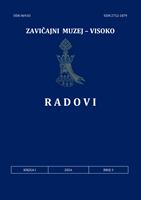Fonetske odlike govora Visokog krajem XIX stoljeća
Phonetic features of Visoko speech at the end of the 19th century
Author(s): Mehmed KardašSubject(s): Cultural history, Social history, Historical Linguistics, Comparative Linguistics, Sociolinguistics, South Slavic Languages, 19th Century
Published by: JU Zavičajni muzej – Visoko
Keywords: jezička anketa; Milan Rešetar; XIX stoljeće; Pitanja o govoru prostoga naroda; govor Visokog; istočnobosanski ijekavskošćakavski dijalekt;
Summary/Abstract: The paper analyzes the phonetic characteristics of Visoko speech based on questionnaires from the famous collection Questions on Simple Folk’s Spoken Language by Milan Rešetar (FAZM, Inventor folkl. zapisa III, Nº 14372–14597). Four questionnaires from this survey were filled out in Visoko as part of the research of Bosnian-Herzegovinian speech at the end of the 19th century, conducted by the Austro-Hungarian Monarchy. Based on the material from these four questionnaires, the following conclusions can be drawn: (1) the questionnaires confirm the two-syllable replacement of the long jat (dijete, mlijeko, rijeka), the monosyllabic in short (vjera, bježati, pjevati). In addition to the expected Ijekavian reflex, questionnaires note the Ekavian reflex in ne- < ně-: neki, nekako, negda, and in the nouns zenica, testa/cesta, while in the prefix prě- forms with e are more common, but Ikavian forms are also recorded: preskočiti/priskočiti, preboljeti/priboljeti, prevaliti/privaliti. In the group rě, forms with rje in krjepost, krjepak, grješnik are more common, while e is in ređi and vreća. Examples of a secondary jat also exist in Visoko speech: pijer, mijer and kosijer, alongside examples with i; (2) the questionnaires record numerous dialectal changes in the vocal system: besides minji, dalji is also spoken as minji and dilji, the word ljubazan is also spoken ljubezan, and the word salamander (daždevnjak) has forms with a and i: dažđevnjak and dižđevnjak; (3) evidence of more archaic speech is preserved in examples of the re group in the noun vrebac (along with vrabac), as well as in the nouns greb and greblje (in addition to grob, groblje), where forms with re are characteristic of Muslim speech; (4) the affiliation with more western speech is also confirmed by the reflexes of Proto-Slavic jotting of the dentals t and d, as seen in tuji, mlaji, slaji (along with tuđi, mlađi, slađi), as well as šća-forms: šćap, šćeta, možđani, zvižđati, etc. Judging by the surveyors’ notes, these occurrences are more prevalent in the speech of Muslims; (5) the sound “h” is preserved in all positions in Visoko speech: hlad, muha, grijeh, rekoh, as well as in the forms lahko and mehko; it is most prevalent in the speech of Muslims, though forms lako and meko are also recorded; (6) the affricate pairs č ~ ć, dž ~ đ in speech of Visoko are reduced to one, as emphasized by all four recorders; (7) the questionnaires confirm numerous dialectal changes in the consonant system: assimilations according to the place of creation (ižljubiti, ražljutiti, pošljednji), rotacism (moreš, more), -dn- > -(n) n- (jena, glana, onio), dissimilations (mlogi), as well as a metathesis that confirms confessional stratification: barjak (Orthodox) ~ bajrak (Muslims). A comparison of the material from the four questionnaires filled in Visoko with the results of research into the speech of Visoko, which were carried out in the middle and second half of the 20th century, confirmed the preservation of the more archaic state in the 20th century as well, but also the loss of certain characteristics – for example, the form vrebac is very rarely heard, as well as the pronoun forms tko, nitko, etc. Certainly, a contemporary examination of Visoko speech would give relevant results about how much the dialectal picture was changed at the end of the 20th and in the first decades of the 21st century.
Journal: Radovi Zavičajnog muzeja - Visoko
- Issue Year: 1/2024
- Issue No: 3
- Page Range: 119-138
- Page Count: 20
- Language: Bosnian

